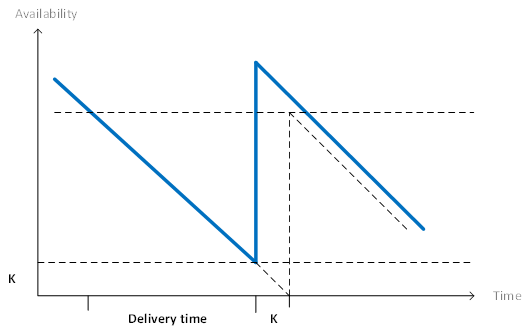The merchandise is often the biggest investment for a Retail business and, on the other hand, the assortment width and depth, plus the absence of stock-outs are fundamental factors in service quality perceived by the customer.
The classic approach for computer assisted replenishment is based on a Minimum Stock (or Reorder Point) for each product, in some cases updated in batch mode with criteria linked to sales past history.
The problems of such an approach, apart from the manual activity required to refresh the Reorder points and the quantity to be ordered, are:
-
Fluctuations in demand due to manufactures’ advertising campaigns or local promotions on the product itself or on replacement products, as well as abnormal meteorological conditions or the entry of new competitors in the local market (new stores) or global (new products)
-
Seasonality
-
Product life-cycle (introduction, maturity or decline phase)
Service Level
To optimize the investment in merchandise and floor space, the basic idea is to order as late as possible and the lowest quantity (but in economical lots, considering both transport and physical management costs) while avoiding, as much as possible, any stock-out. This is clearly a probabilistic problem because the certainty would have an exaggerated cost. On the other hand a 90% Service Level, that means having stock-out for no more than 10% of the products and no more than 10% of the time, can be consistent with a Store / Chain price and image level. In other cases a higher Service Level is required, for example of 95 or 98%, associated with greater investment in stock and floor space.
Availability Days
The main concept for these considerations is Availability Days, the number of days for which a product stock will remain available for sale:

The Availability (Stock + Pending Purchase Orders – Pending Reservations from customers) is easy to calculate, while the forecast is more complex. The mathematical algorithm used by aKite is called “exponential smoothing”, well suited for short-term forecasts. It shows a first estimate after the second sale and takes in account non-sale days during stock-out. The algorithm also detects if the trend is increasing or decreasing and if the change is moderate or strong, or if it is relatively stable and the fluctuations are large or limited. It also signals if the trend is extremely unstable. These factors influence the stock required to obtain a pre-defined Service Level. The greater is the forecast uncertainty and the higher the security level K necessary to ensure a high Service Level.
Let’s consider two simple examples:
Product A) Stock = 10 Pcs – Forecast = 1 unit / day
Product B) Stock = 50 Pcs – Forecast = 10 Pcs / day
Which of the two is expected to run out first?
The Availability Days forecasted for A are 10/1 = 10 while for B are 50/10 = 5. Then B, despite having a significantly higher stock, will likely run out before A.
Delivery time
The other important parameter is the Delivery Time. If Product A supplier had a delivery time of 20 days, then it is already too late to order (forecasted availability is for 10 days), but if delivery time is 5 days, it is possible to wait for a further stock reduction.

The diagram show the K factor that reduces the risk of “out of stock” with an actual delivery time longer than expected or a sudden increase in the sales pace. The problem is that increasing excessively and indiscriminately in the K-factor, increases the Service Level but also the stock, with excessive investment. aKite automatically sizes the factor K as a function of various parameters.
Best Delivery Conditions
Often 80% of a store merchandise range is made up of “slow moving” items, but nonetheless essential for a good customer service level. For these items, the critical factor is usually not the delivery time, but the minimum purchase, often linked to the package contents, which can be 6, 12, 24, .. or 10, 20, 100, … pieces.
For example, with a minimum order of 12 pieces and sales forecast of 1 unit per month, an quantity that will be sold in about one year, it becomes less important if the hypothetical manufacturer ACME delivers in 5 or 20 days. An alternative supplier that would provide the same product in individual pieces, although with a slightly longer delivery time, would be more convenient. The convenience would reverse if the minimum purchase of 12 pieces would cover the sales for just one week and not for one year.
When there are alternative suppliers for the same product, the choice of the one with the best delivery conditions therefore depends on the Minimum order, the Delivery time, but especially on the sale pace of the product. aKite is able to make dynamically this choice, in addition to privilege the Preferred supplier and / or the one with the Minimum price.

An approach for creating optimum automatic replenishment proposals is to set Reordering points low, compatible with low sales pace or minimum display, and consider ALSO Sales Forecast and Delivery Time criteria for not running out of goods in high sales times, but at the same time minimizing the stock investment in relation to the target Service Level.
Conclusions
The IT problem has never been the quantity, but the relevance of the data provided for human decision support. With the Cloud near-infinite resources, the frontier moves to automation that reflect market dynamics on the daily execution as, for example, optimal purchase orders or issuing coupons highly significant for the customer.
Archivio
35010 Vigonza (PD)
P.IVA/C.F: 02110950264
REA 458897 Cap.soc. 50.000€
Software
Blog
© Copyright 2023 aKite srl – Privacy policy | Cookie policy